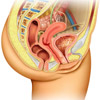What you need to know about pelvic inflammatory disease
Pelvic inflammatory disease (PID) might not be featured on the back of as many toilet doors as the herpes virus or HIV, but just the same it is a condition resulting from sexually transmitted infections (STIs) that needs attention. PID affects the upper female genital tract (fallopian tubes, womb and ovaries). So not only can it make you sick but, eventually, it can cause infertility. Luckily for us active ladies, this condition is preventable and treatable – meaning you can take control of your sexual health before it takes control of you.
Here’s lookin’ at you, Kid
The important thing to remember is that if you feel you may need to be checked out for PID, there’s no need to panic. PID hasn’t singled you out. In fact, it is a very common condition experienced by 10–15% of the female population, and women between the ages of 20 and 24 are its ‘target market’.
PID is nearly always caused by chlamydia or gonorrhoea. These two sneaky bugs normally affect the lower genital tract, namely your vagina. However, PID affects the parts you can’t see – making it just as sneaky and important to monitor.
So if you protect yourself from these STIs through safe sex practices, you are also protecting yourself from PID. Of course, sometimes practising safe sex doesn’t occur for a variety reasons, so it’s a good thing that PID is treatable as well as preventable.
In addition, a small proportion of women will experience an STI as a result of genital procedures, including abortion and intrauterine device (IUD) insertion.
Be wise: Recognise
It’s difficult to recognise when you have PID, often because you won’t experience genital symptoms, or the symptoms you do experience are also common to other conditions. However, we do know that the following may indicate PID:
- Lower abdominal pain or pain and tenderness in the genital tract;
- Pain during sexual intercourse;
- Vaginal discharge;
- Irregular vaginal bleeding;
- Fever;
- Nausea and vomiting;
- Increased temperature and/or pulse rate.
If you are experiencing any of these symptoms, you need to visit your doctor anyway. Your GP may ask you some questions about your sexual or reproductive experiences. They aren’t being nosey – they just need background because your experiences will indicate whether you are at risk.
If you do appear to be at risk, then you can get on with some tests and get on with your life. This is a good thing, so don’t be scared to get checked out.
Doctor, doctor give me the news!
In order for a doctor to adequately test you for PID, there are some other tests they must perform besides asking a few questions.
First of all, the doctor has to get pretty personal with your vagina because it is a condition affecting the genital tract. As usual, the only way in … is up. So be prepared if the doctor must test secretions from your vagina and feel the internal genital organs. He or she may also need to take a swab of secretions for testing.
When the secretions are tested, the lab will look for bacteria that may be causing PID.
Transvaginal ultrasounds may also be of use. This means a camera will go into your vagina. The images will allow the doctor to see the uterus, fallopian tubes and ovaries, and any abnormal lumps or masses that may indicate an infection. At least your vagina will get its 15 minutes!
Treat it and beat it
You can beat PID. Antibiotic treatment is effective in clearing the infection and symptoms in 88–100% of women. For women who are experiencing very severe PID, hospitalisation may be required so they can get the antibiotics straight into your blood via a drip.
Usually, though, some tablets are enough to clear up your PID, and they often only need to be taken for a fortnight. It is imperative to follow the doctor’s orders and keep on the treatment until the course is finished.
Treating PID as soon as possible is incredibly important because infertility and ectopic pregnancy are also more common in PID-affected women, particularly if treatment was delayed.
Spread love, not PID
As PID is usually sexually transmitted, it is important that all your recent sexual partners are screened for STIs and treated with antibiotics if they have an infection. Scared? Don’t be. This is a very common part of a normal community. If you have contracted an STI, that means other people have too, right? If you need a little help getting on the blower, there are health professionals who can help you make those important calls.
Also, remember: no sex until you’re treated. This goes for you partner too. When you have the green light, you can go for gold. And while the symptoms will vanish, you may experience pelvic pain from time to time.
She who hesitates …
PID is serious, but thankfully you can say goodbye to it forever through a course of antibiotics and practising safe sex. So if you feel you may be at risk, see your doctor immediately. The real danger comes from hesitation.
More information
 | For more information, see Pelvic Inflammatory Disease. |
Dates
Created by:

 Login
Login














